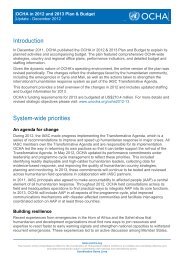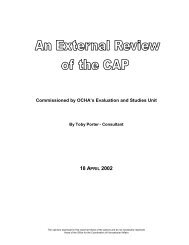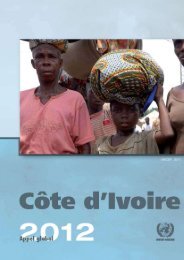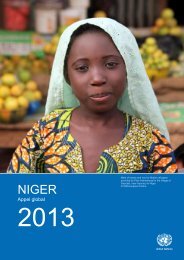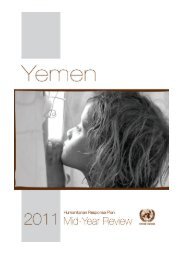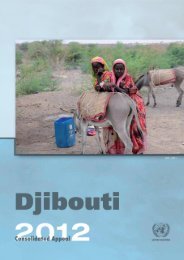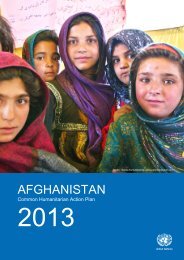SUDAN
Sudan: UN and Partners Work Plan 2012 - ReliefWeb
Sudan: UN and Partners Work Plan 2012 - ReliefWeb
- No tags were found...
You also want an ePaper? Increase the reach of your titles
YUMPU automatically turns print PDFs into web optimized ePapers that Google loves.
64[3] Sector Response plans United Nations and Partners<strong>SUDAN</strong> WORK PLAN 2012Non-food items andemergency shelterbSector objectives1. To provide needs-based and timely non-food items andemergency shelter to people affected by conflict anddisaster, returnees, and other vulnerable populations.2. To facilitate coordination, timely information sharing andcapacity building amongst all partners and stakeholdersin the sector.3. To expand the provision of environmentally friendly andlocally acceptable emergency shelter, using regionallyproduced and/or externally sourced materials.Key sector info (NFI/ES)Lead agency(s)Gov't leadImplementingagenciesProjectsBeneficiariesFunds requestedFunds requestedper priority levelContact infoThe Office of the United Nations High Commissioner forRefugees - UNHCRMinistry of Humanitarian Affairs (HAC)AORD, Concern Worldwide, CRS, DDA, DWHH (GAA),El Ruhama, GFO, GOAL, HCO, HelpAge International,Intersos, MC Scotland, NCA, OXFAM-America, Plan,PODR, RDN, SAG SC, Sudan RC, Tearfund, UMCOR,UNHCR, WR.29 projects294,000 households$37.44 million$31.36 million (high)$6.08 million (medium)Diana Chikuwa: diana.chikuwa@wfp.orgDavid Wemyss: david.wemyss@wfp.org.Needs analysisThe NFIs and ESSector provides support to beneficiaries on aneeds-based strategy. The majority of NFI related needs arefound in Darfur, where approximately 1.9 million people remaindisplaced, and the three Protocol Areas, where many peoplehave been displaced due to the outbreak of fighting. Sincethe items are temporary and not intended to be long-termsolutions, replenishment of key seasonal items is necessaryto support IDPsfacing long-term displacement. During 2011,the sector increased its focus towards promoting sustainableshelter solutions for protracted displacements to encourageself-reliance and decrease aid dependence, as well as providingassistance for returnees in West Darfur. The strategy forshelter solutions will be expanded in 2012. The capacity ofcommunities will be increased simultaneously to enhance theircoping mechanisms using locally available shelter materialsand alternative building techniques. The sector lead is planningto procure environmentally friendly shelter kits for distributionand to engage a shelter expert to provide guidance.To effectively respond to victims of civil unrest and naturaldisasters, it is crucial to have strategic stocks positioned in keyhubs throughout the country for rapid intervention. Internationalprocurement lead times for NFI and ES stocks range fromthree to six months and local procurement is utilized whereverpossible. Funding must be secured by January to ensure rainyseason replenishment stocks are procured and effectively prepositionedbefore the rains begin in June, whilst procurementof winter season replenishment items must begin in March, fortimely distribution beginning October.Timely funding for procurement and timely positioning willcontinue to be instrumental in effective response by the sectorin 2012. The substantial caseload supported by the NFI andES Sector in Sudan requires effective synchronization andmanagement to ensure agencies are well coordinated tomaximize economies of scale while simultaneously providinguniformity in aid delivered and minimizing gaps and overlapsin activities and geographical coverage.The sector priorities are:NFI 2012 caseload by beneficiary type (in housholds)State Targeted beneficiaries ContingencycaseloadIDPs Newly displaced(eferendumrequiring and disasteraffectedhoush-relatedreplenishmenoldsdisplacement)Rest of Sudan 5,000 119,000N. Darfur 24,000 11,000S. Darfur 43,000 25,000W. Darfur 28,000 14,000Sub Total 95,000 55,000 7,000Total NFI CP caseload 269,000Other pipelines 25,000Total sector caseload 294,000• Continue capacity-building of all partners, especiallynational NGOs and local counterparts. Increase interactionwith HAC and Government entities in planning andoperations.• Promote the importance of ensuring that women, girls,boys and men are regularly consulted about their NFIand ES needs and that they are equally engaged andconsulted in the planning and distribution of NFI and ESitems among the beneficiaries assisted.• Ensure emergency response capacity within the sector ismaintained for Darfur and the three Protocol areas.• Provide immediate, life-saving NFI and ES items, basedon assessed needs, to populations newly displaced as aresult of conflict or natural disasters, or those in rural andnewly accessed areas to protect them from the elements.• Ensure populations that remain displaced are providedwith key seasonal replenishment items based on needsassessments that prioritize those most in need.• Support IDP returnees, both spontaneous and organized,in accordance with the returns framework and based onassessed needs.• Promote sustainable projects among long-term IDPs withthe provision of environmentally-friendly shelter materialsand alternative building techniques which have links tosubstantial livelihood developments.• Coordinate NFI and ES response to emergencies efficientlyto prevent overlaps in activities and ensure coverageof gaps in priority locations.• Secure early funding for the timely procurement of essentialstocks to prevent pipeline delays or breaks; securetimely funding to support all other sector activities.




